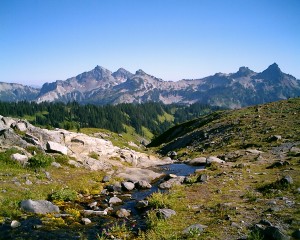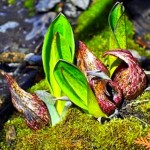I remembered being light headed and giddy. The man who had brought me to that secluded place held me tight as we leaned against the rocks of an adjoining mountainside. The air tickled my lungs in a way that a city girl—I was from Detroit—rarely experienced. There was a purity and thinness between where we stood on the alpine tundra, and God.
I had taken the summer off before beginning a graduate program at Michigan State University. He was a friend of a friend, a geologist, and worked as an oil drilling engineer—of sorts. He lived in Colorado and part of his job was hiking and surveying the land his company thought productive for drilling. He and his sister had planned several backwoods hiking adventures for the summer and he’d offered to fly me out to join them.
I had done a lot of hiking, cross-country skiing, and canoe portages around the Great Lakes. Not until that summer, over thirty-five years ago, had I seen mountains. We backpacked several trails throughout the Rockies, Tetons, Pikes Peak, and the Big Horn. What I experienced that summer was exhilarating and grueling. And I had thought myself fit! One such hike took us from a sweltering near ninety degrees at the ranger’s station, to snow gear a day and a half up a mountain.
Those memories came forward during morning prayers while reading a reflection in Magnificat (Aug 2014, p.52) by Sherry A. Weddell. Her description of Pike’s Peak Barr Trail sent my thoughts to wandering along rocky paths, sitting on cliffs bordering raging rivers, through forests, and gasping at the sight of being surrounded by alpine tundra wildflowers.
Sherry wrote of the challenges to reach Pike’s Peak summit on foot.
A small child could be carried up Pikes Peak, but adults cannot simply wander up to the summit casually, much less passively. They have to spend some seriously strenuous hours covering nearly thirteen miles…nearly five thousand feet through foothills, the montane (forest), and then the sub-alpine zone before climbing another three thousand feet beyond the tree line.
The air at the summit is thin, having less oxygen. The farther one goes hiking the trail, the more challenging the journey becomes. I remembered this from personal experience. I had not been trained, physically conditioned, in high-altitude environments, so for my safety hiking up only went so far. Even at that I’d felt the mild side of mountain sickness—lightheadedness. To reach a summit is not, as Sherry said, a casual thing. Learning and conditioning come first in order to persevere in thin air.
It is to that intentionality that she speaks regarding Communion:
I don’t think it is an accident that the Church uses the metaphor of a summit to convey the significance of the Eucharist. The Eucharist is described as the summit, the apex, and the pinnacle of the Christian life….Just as we have actively to climb a mountain summit, we have to make an intentional journey, properly prepared, fully to receive the inexhaustible grace to be found in the Eucharistic Christ.
Any mountain climber or backwoods hiker will tell you, preparation is everything.
With that, let us pray that through the intercession of St. Bernard of Menthon for the protection of all who travel in the mountains of this earth, and the mountains in our souls, that they be granted strength and fortitude as they seek. Amen













